Rapido has been producing motorhomes at its factory in Mayenne – just east of Le Mans – since the very early 1980s, and integrals (A-class motorhomes) since 1990. Here, I’m focusing on this century’s Rapido integrals based on the Mercedes-Benz Sprinter chassis-cowl (2000-2015).
These are variously referred to as the M Series (suffix M) or 900 Series, although rather confusingly, there are also 900 Series variants based on the Fiat Ducato, which have the suffix F.
All were originally built on rear-wheel-drive Sprinters featuring a 121bhp turbocharged diesel engine.
The fabricated in-house coachwork is in Polyglace, a 100% polyester material. The new millennium’s offer comprised five models over two lengths, all with a transverse drop-down double bed located above the cab.
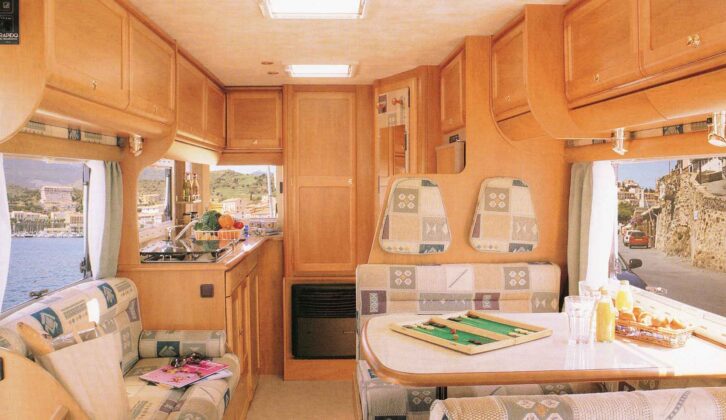
Stretching the tape to 6.0m/19’ 8.25” were 923M, 925M and 941M. 923 and 925 included a forward nearside double Pullman dinette with a short offside settee opposite; both ahead of a nearside rear-corner washroom and an offside rear-corner kitchen.
The only difference was that the washroom in the 925M was bigger and included a separate walk-in shower.
941M replaced the Pullman dinette with an L-shaped settee and added a permanent European-style nearside rear corner double bed.
The two 6.57m/21’ 7” models also featured a rear corner bed. 970M had a forward double Pullman dinette, whereas 972M opted for a half-dinette and a bigger kitchen.
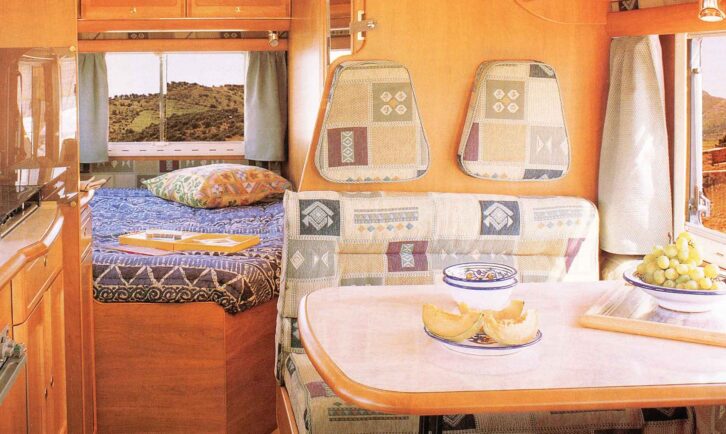
a fave of the author
Later, an additional longer model appeared, 962M, with an adjustable-height permanent transverse double bed above a full-width garage.
By 2003, the three shorter models had all been dropped, replaced by several stretched existing motorhome layouts.
The most significant newcomer was the 976M, a family motorhome which came with twin bunks set along the offside towards the rear, increasing the ’van’s sleeping capacity to five adults, or four adults and two children. An optional chassis upgrade to 3800kg facilitated a better payload.
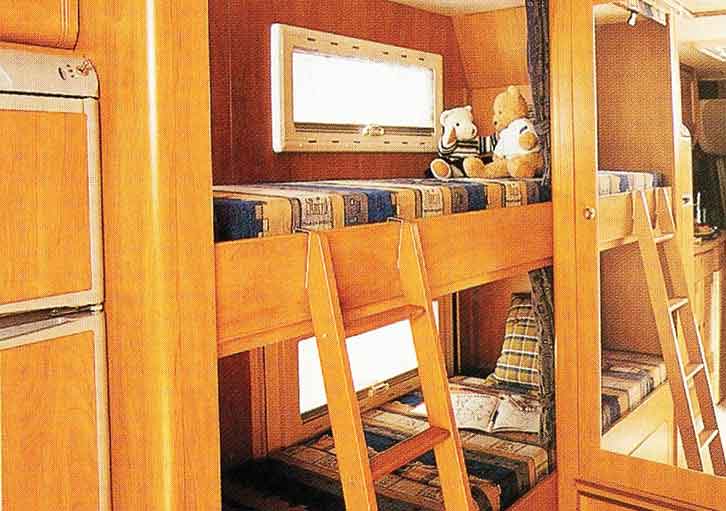
The (by then) overextended range was rationalised in 2008. Baby of the line-up was now the 6.26m/20’ 6.5” 942M, with rear corner bed and washroom alongside.
Next up were those measuring 6.64m/21’ 9.5”. 962M had the garage, 966M, longitudinal single beds.
The remainder (972M/985M/986M) all arrived with a rear corner double bed, but there were slight differences in the forward lounges.
2009 saw significant changes. Heavily revised coachwork was now cream with metallic oatmeal-coloured skirts. It contained new (much darker) furniture, and for the first time, two layouts with an island double bed.
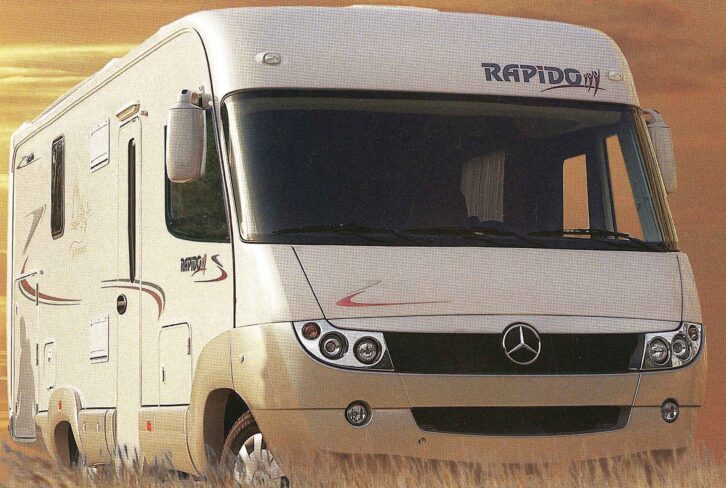
In addition, twin rear-wheel heavy-duty underpinnings became a cost option. Unsurprisingly, they’d all grown a bit as well – shortest models were now longer than the flagship was in the year 2000! The remainder were 7.4m/24’ 3.5”. 986M boasted a rear corner double bed, whereas 685M featured a high-level transverse double bed above a garage.
The two island-bed variants were the 991M (head end against the offside wall) and 992M (head end against the rear wall). Another newbie was the 999M, which placed a corner bed not quite at the far rear, but just ahead of a full-width washroom. Extra-cost heavy-duty models bore the suffix MH.
Not all of the recent changes curried favour. 2010 saw the replacement of the rather sombre 2009 furniture with ‘designer’ cabinetwork, with light-coloured high-gloss relief panels, adding a much more contemporary vibe. The Alde domestic-style central heating system also became standard.
We bade farewell to this generation of production Merc integrals in 2015, although some LHD examples continued to be built to special order.
Base vehicle
As always, look for a full service history and a long MoT. Sprinter spares are (relatively) easy to obtain, even for very early models.
Soft suspension and a roly-poly ride plagued early vehicles, although this can be alleviated by the addition of air suspension assistance.
The early longer, non-heavy-duty chassis examples had limited payload, especially if many retrofit accessories had been added – if you’re not sure how much you may need, see what Motorhome Matt had to say when he considered “how much payload do you really need?”.
An automated manual gearbox, the Sprintshift, offered a two-pedal drive. It was criticised by testers at the time, although I feel a lot of this was unjustified. Time has proved it to have been extremely reliable… if a little ponderous!
Conversion
When you’re buying a used motorhome, you should carefully check for signs of water ingress, especially around the site of retrofit accessories. That said, Rapido coachbuilts are among the least prone to suffering damp issues.
Insist on a recent habitation service on all safety-critical items. Check smoke and gas alarms.
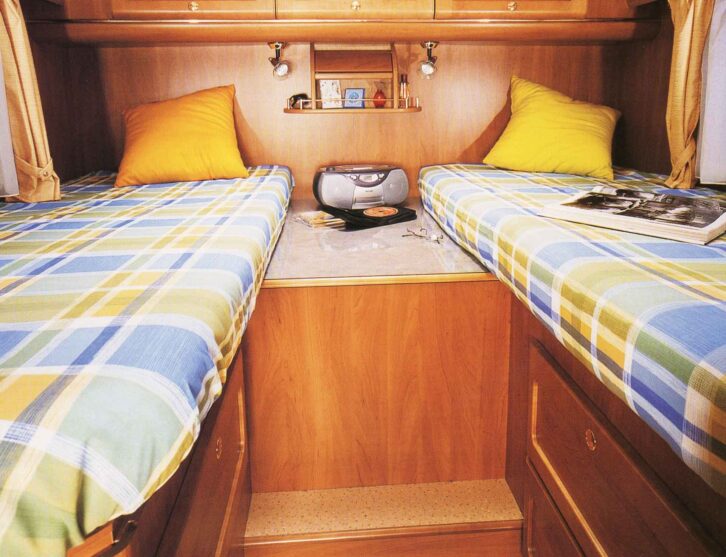
Rapido’s penchant for continually marginally increasing the length of models, and its amazing flexibility – shown in allowing original purchasers the cost option of mixing and matching layouts – has resulted in a bespoke aspect to many offered for sale pre-owned… which might not suit subsequent buyers.
My personal favourite is the early (very compact) 923M, although to be fair, there isn’t a lemon among them!
What we like about a used Rapido integral on a Mercedes Benz
- Affordable luxury
- Dependable base vehicle
- Original Maple cabinetwork
- Polyester coachwork
What we dislike about a used Rapido integral on a Mercedes Benz
- Conversion not handed for UK
What to pay for a Rapido integral on a Mercedes Benz
All of the ’vans featured here were a well-built, highly specified, premium product, and they make a thoughtful pre-owned purchase. They weren’t a mass-market motorhome, thus were not sold in huge numbers.
If you spot a good ’un, don’t hesitate. Most are north of £40,000, but I did spot a fully loaded range-topping 2009 992MH (twin rear-wheel drive) for sale at Rove! Motorhomes (Selston) for an approachable £31,995. It’s a one-owner example with the 3.0-litre engine.
Equivalent RRP today (Rapido Distinction i196M) is almost £160,000.
Essentials
- Rapido M Series on Mercedes-Benz Sprinter chassis-cowl
- Built 2000-2015 in Mayenne, France
- Two-door integral (A-class) coachbuilt
- Overall length: 6.0m (19’ 8”) to 7.4m (24’ 3.5”)
Alternatives to consider
All integrals/A-class: Mercedes Sprinter based examples from Pilote, Hymer and Laika. Fiat Ducato based examples from Rapido Group under the Rapido 900F Series and Itineo marques.
Alternatively, you could consider a used Roller Team Pegaso – this contemporary vehicle (2017-present) offers a more contemporary vibe than the Rapido I’ve looked at here, as well as generous bed sizes. Or you could think about a used Adria Sonic Supreme, an A-class, which offers luxurious accommodation and a commanding driving position.
If you’ve enjoyed reading this article, why not get the latest news, reviews and features delivered direct to your door or inbox every month. Take advantage of our brilliant Practical Motorhome magazine SUBSCRIBERS’ OFFER and SIGN UP TO OUR NEWSLETTER for regular weekly updates on all things motorhome related.
Leave a Reply